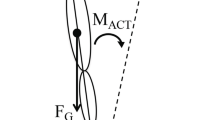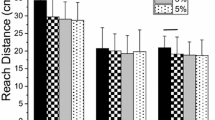Abstract
This study addresses the question of how posture and movement are oriented with respect to the direction of gravity. It is suggested that neural control levels coordinate spatial thresholds at which multiple muscles begin to be activated to specify a referent body orientation (RO) at which muscle activity is minimized. Under the influence of gravity, the body is deflected from the RO to an actual orientation (AO) until the emerging muscle activity and forces begin to balance gravitational forces and maintain body stability. We assumed that (1) during quiet standing on differently tilted surfaces, the same RO and thus AO can be maintained by adjusting activation thresholds of ankle muscles according to the surface tilt angle; (2) intentional forward body leaning results from monotonic ramp-and-hold shifts in the RO; (3) rhythmic oscillation of the RO about the ankle joints during standing results in body swaying. At certain sway phases, the AO and RO may transiently overlap, resulting in minima in the activity of multiple muscles across the body. EMG kinematic patterns of the 3 tasks were recorded and explained based on the RO concept that implies that these patterns emerge due to referent control without being pre-programmed. We also confirmed the predicted occurrence of minima in the activity of multiple muscles at specific body configurations during swaying. Results re-affirm previous rejections of model-based computational theories of motor control. The role of different descending systems in the referent control of posture and movement in the gravitational field is considered.






Similar content being viewed by others
References
Andronov AA, Vitt AA, Khiken SE (1966) Theory of oscillators. Pergamon Press, Oxford
Asatryan DG, Feldman AG (1965) Functional tuning of the nervous system with control of movements or maintenance of a steady posture: I. Mechanographic analysis of the work of the joint on execution of a postural task. Biophysics 10:925–935
Belen’kiĭ VE, Gurfinkel’ VS, Pal’tsev EI (1967) Control elements of voluntary movements. Biofizika 12:135–41
Beloozerova IN, Zelenin PV, Popova LB, Orlovsky GN, Grillner S, Deliagina TG (2003) Postural control in the rabbit maintaining balance on the tilting platform. J Neurophysiol 90:3783–3793
Colby CL (1998) Action-oriented spatial reference frames in cortex. Neuron 20(1):15–24
Cole J, Paillard J (1995) Living without touch and information about body position and movement. Studies on deafferented subjects. In: Bermudez J, Marcel A, Iylan N (eds) The body and the self. MIT Press, Cambridge, pp 245–266
Cordo PJ, Nashner LM (1982) Properties of postural adjustments associated with rapid arm movements. J Neurophysiol 47:287–302
Deliagina TG, Orlovsky GN, Zelenin PV, Beloozerova IN (2006) Neural bases of postural control. Physiology (Bethesda) 21:216–225
Deliagina TG, Beloozerova IN, Orlovsky GN, Zelenin PV (2014) Contribution of supraspinal systems to generation of automatic postural responses. Front Integr Neurosci 28:76
Feldman AG (2015) Referent control of action and perception. Springer, New York
Feldman AG (2016) The relationship between postural and movement stability. Adv Exp Med Biol 957:105–120
Feldman AG, Levin MF (1995) The origin and use of positional frames of reference in motor control. Behav Brain Sci 18:723–806
Feldman AG, Orlovsky GN (1972) The influence of different descending systems on the tonic stretch reflex in the cat. Exp Neurol 37:481–494
Feldman AG, Goussev V, Sangole A, Levin MF (2007) Threshold position control and the principle of minimal interaction in motor actions. Prog Brain Res 165:267–281
Fitzpatrick R, Day B (2004) Probing the human vestibular system with galvanic stimulation. J Appl Physiol 96:2301–2316
Ghafouri M, Feldman AG (2001) The timing of control signals underlying fast point-to-point arm movements. Exp Brain Res 137:411–423
Ghez C, Hening W, Gordon J (1991) Organization of voluntary movement. Curr Opin Neurobiol 1:664–671
Gottlieb GL, Agarwal GC (1979) Response to sudden torques about ankle in man: myotatic reflex. J Mot Behav 11(2):123–133
Hadders-Algra M, Carlberg EB (2008) Postural control: a key issue in developmental disorders. Mac Keith Press, London
Heckman CJ, Hyngstrom AS, Johnson MD (2008) Active properties of motoneurone dendrites: diffuse descending neuromodulation, focused local inhibition. J Physiol 586:1225–1231
Hislop HJ, Montgomery J (1995) Daniels and Worthingham’s muscle testing: techniques of manual examination. WB Saunders, Philadelphia
Hollerbach JM (1982) Computers, brains, and the control of movement. Trends Neurosci 5:189–192
Horak FB, Macpherson JM (1996) Postural orientation and equilibrium. In: Rowell LB, Shepherd JT (eds) Handbook of physiology 1. Exercise: regulation and integration of multiple systems. Oxford University Press, New York, pp 255–292
Horak FB, Nashner LM (1986) Central programming of postural movements: adaptation to altered support surface configurations. J Neurophysiol 55:1369–1381
Horak FB, Diener HC, Nashner LM (1989) Influence of central set on human postural responses. J Neurophysiol 62:841–853
Hultborn H, Brownstone RB, Toth TI, Gossard JP (2004) Key mechanisms for setting the input-output gain across the motoneuron pool. Prog Brain Res 143:77–95
Ilmane N, Sangani S, Feldman AG (2013) Corticospinal control strategies underlying voluntary and involuntary wrist movements. Behav Brain Res 236:350–358
Imamizu H, Uno Y, Kawato M (1998) Adaptive internal model of intrinsic kinematics involved in learning an aiming task. J Exp Psychol Hum Percept Perform 24:812–829
Kawato M (1999) Internal models for motor control and trajectory planning. Curr Opin Neurobiol 9(6):718–727
Matin E (1974) Saccadic suppression: a review and an analysis. Psychol Bull 81:899–917
Matthews PBC (1959) A study of certain factors influencing the stretch reflex of the decerebrated cat. J Physiol 147:547–564
Mattos DJ, Latash ML, Park E, Kuhl J, Scholz JP (2011) Unpredictable elbow joint perturbation during reaching results in multijoint motor equivalence. J Neurophysiol 106:1424–1436
Mattos D, Schöner G, Zatsiorsky VM, Latash ML (2015) Task-specific stability of abundant systems: structure of variance and motor equivalence. Neurosci 310:600–615
Maurer C, Mergner T, Bolha B, Hlavacka F (2000) Vestibular, visual, and somatosensory contributions to human control of upright stance. Neurosci Lett 281:99–102
Mezzarane RA, Kohn AF (2007) Control of upright stance over inclined surfaces. Exp Brain Res 180:377–388
Micheau P, Kron A, Bourassa P (2003) Evaluation of the lambda model for human postural control. Biol Cybern 89:227–236
Miranda Z, Pham A, Barthélemy D (2014) Presynaptic control of balance in healthy subjects. ISPGR World Congress. Abstract no P3-K-50, Vancouver, p 71
Nashner LM (1976) Adapting reflexes controlling the human posture. Exp Brain Res 26:59–72
Perez MA, Rothwell JC (2015) Distinct influence of hand posture on cortical activity during human grasping. J Neurosci 35:4882–4889
Peterka RJ (2000) Postural control model interpretation of stabilogram diffusion analysis. Biol Cybern 82:335–343
Peterka RJ (2002) Sensorimotor integration in human postural control. J Neurophysiol 88:1097–1118
Pilon J-F, De Serres SJ, Feldman AG (2007) Threshold position control of arm movement with anticipatory increase in grip force. Exp Brain Res 181(1):49–67
Raptis H, Burtet L, Forget R, Feldman AG (2010) Control of wrist position and muscle relaxation by shifting spatial frames of reference for motoneuronal recruitment: possible involvement of corticospinal pathways. J Physiol 588:1551–1570
Sangani SG, Raptis HA, Feldman AG (2011) Subthreshold corticospinal control of anticipatory actions in humans. Behav Brain Res 224:145–154
Sasagawa S, Ushiyama J, Masani K, Kouzaki M, Kanehisa H (2009) Balance control under different passive contributions of the ankle extensors: quiet standing on inclined surfaces. Exp Brain Res 196:537–544
Schieppati M, Nardone A (1995) Time course of ‘set’-related changes in muscle responses to stance perturbation in humans. J Physiol 487:787–796
St-Onge N, Feldman AG (2004) Referent configuration of the body: a global factor in the control of multiple skeletal muscles. Exp Brain Res 155:291–300
Sussillo D, Churchland MM, Kaufman MT, Shenoy KV (2015) A neural network that finds a naturalistic solution for the production of muscle activity. Nat Neurosci 18:1025–1033
Todorov E, Jordan MI (2002) Optimal feedback control as a theory of motor coordination. Nat Neurosci 5:1226–1235
Tomita Y, Feldman AG, Levin MF (2016) Referent control and motor equivalence of reaching from standing. J Neurophysiol. https://doi.org/10.1152/jn.00292.2016
Turpin NA, Levin MF, Feldman AG (2016) Implicit learning and generalization of stretch response modulation in humans. J Neurophysiol 115:3186–3194
von Holst H (1954) Relations between the central nervous system and the peripheral organs. Br J Anim Behav 2:89–94
von Holst E, Mittelstaedt H (1950/1973) Das reafferenzprinzip. Naturwissenschaften 20:464–476 (English translation. Martin R (1973) The reafference principle. In: the behavioral physiology of animals and man. The collected papers of Erich von Holst. University of Miami Press, Florida)
Welch TD, Ting LH (2009) A feedback model explains the differential scaling of human postural responses to perturbation acceleration and velocity. J Neurophysiol 101:3294–3309
Winter DA (2009) Biomechanics and motor control of human movement. John Wiley, New Jersey
Winter DA, Patla AE, Prince F, Ishac M, Gielo-Perczak K (1998) Stiffness control of balance in quiet standing. J Neurophysiol 80:1211–1221
Wolpert DM, Kawato M (1998) Multiple paired forward and inverse models for motor control. Neural Netw 11:1317–1329
Zatsiorsky VM, Duarte M (2000) Rambling and trembling in quiet standing. Motor Control 4:185–200
Zhang L, Turpin NA, Feldman AG (2017) Threshold position control of anticipation in humans: a possible role of corticospinal influences. J Physiol 2017 595:5359–5374
Acknowledgements
Study supported by NSERC (AGF). AAM received a doctoral fellowship from Heart and Stroke Foundation of Canada. MFL holds a Canada Research Chair in Motor Recovery and Rehabilitation. Authors wish to thank Dorothy Barthélemy and Anouk Lamontagne for help in data collection as well as the individuals who volunteered for the study.
Author information
Authors and Affiliations
Contributions
The work was performed at the research centres of the Jewish Rehabilitation Hospital and the Institut de readaptation Gingras-Lindsay de Montreal, sites of the Center for Interdisciplinary Research in Rehabilitation, Montreal, Quebec. AGF and MFL conceived of the research design, AAM, SCH, SKS and AGF participated in data collection, AAM and NT performed data analysis. AGF, MFL and AAM interpreted the data and drafted the final version of the manuscript. All authors approved the final version of the manuscript and agree to be accountable for all aspects of the work in ensuring that questions related to the accuracy or integrity of any part of the work are appropriately investigated and resolved. All persons designated as authors qualify for authorship, and all those who qualify for authorship are listed.
Corresponding author
Ethics declarations
Conflict of interest
All authors state that they have no competing interests.
Rights and permissions
About this article
Cite this article
Mullick, A.A., Turpin, N.A., Hsu, SC. et al. Referent control of the orientation of posture and movement in the gravitational field. Exp Brain Res 236, 381–398 (2018). https://doi.org/10.1007/s00221-017-5133-y
Received:
Accepted:
Published:
Issue Date:
DOI: https://doi.org/10.1007/s00221-017-5133-y




